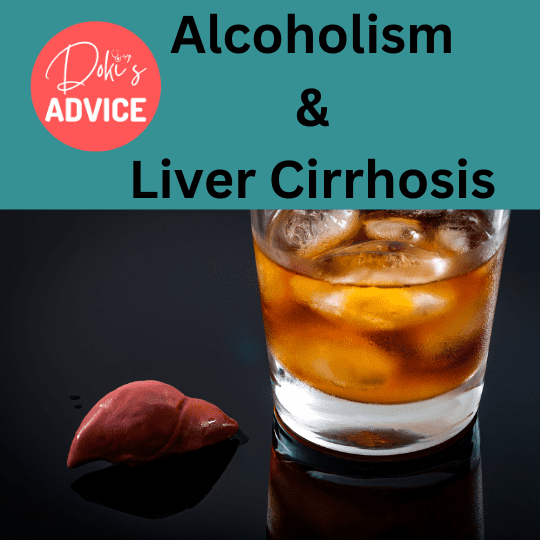Alcoholism & Liver Cirrhosis

According to WHO data in 2020 Deaths caused by liver diseases in Kenya were about 13,400 or 5.09% of the total deaths. With an age rate of 57.44 deaths per 100,000 of the population, ranking Kenya at number 6 in the world.
Leading causes of death in Kenya as per worldlifeexpectancy.com sept/2020
- Stroke: 11,453 deaths
- Influenza and pneumonia:16,263
- Coronary Heart diseases:8,626
- Liver diseases:9,658
- TB:14,162
- HIV/AIDS:15,048
- Road accidents:10,723
- Malaria: 9,116
- Diabetes mellitus:4,072
- Hypertension:3,183
- Lung diseases:3.084
- Cervical cancer:2,441
- Prostate cancer: on this date no Data
- Kidney diseases:3,216
Liver cirrhosis is a condition where the liver becomes scarred and damaged over time, which can prevent it from performing its important functions. Let’s break down these functions in a simpler way:
- Detoxification: The liver helps remove harmful substances like drugs, alcohol, and ammonia from the body.
- Metabolism: It converts certain hormones and substances into forms that the body can use. For example, it activates a thyroid hormone called T4 into its active form, T3.
- Cholesterol production: The liver produces cholesterol, which is important for various functions in the body.
- Blood sugar balance: It helps regulate the amount of sugar (glucose) in the bloodstream by removing excess glucose and storing it as glycogen.
- Bile production: The liver produces bile, a substance that aids in the digestion of fats.
- Protein synthesis: It creates important proteins like albumin, which is crucial for maintaining proper blood circulation, and factors needed for blood clotting.
- Blood filtration: The liver filters the blood, removing toxins, by-products, and other harmful substances.
In liver cirrhosis, the liver’s ability to perform these functions is compromised due to the scarring and damage it has undergone.
Liver cirrhosis can have various causes. Here are some common ones:
- Excessive alcohol consumption over many years can lead to liver cirrhosis.
- Virus infections can also cause liver cirrhosis, such as:
- Hepatitis A: Contracted through contaminated food or drinks, especially seafood, or direct contact with an infected person. However, it usually doesn’t lead to cirrhosis as most people recover fully and develop lifelong immunity.
- Hepatitis B and C: Transmitted through sexual intercourse with an infected person, sharing needles, or from mother to child during pregnancy or delivery.
- Hepatitis E: Ingestion of contaminated water containing fecal matter from infected individuals. This type of hepatitis is typically self-limiting and doesn’t usually result in cirrhosis.
- Hepatitis D: Often occurs as a co-infection with Hepatitis B.
- Non-alcoholic steatohepatitis (NASH): This condition is characterized by the buildup of excess fat in the liver and is commonly seen in individuals with diabetes mellitus.
Liver cirrhosis can be classified as either:
- Compensated: This is when one suffers from cirrhosis but has no acute symptoms like the one’s that will be discussed below.
- Decompensated: This is when the listed below symptoms occur.
The signs and symptoms of liver cirrhosis can vary, but here are some common ones:
- Loss of appetite
- Weight loss and muscle wasting
- Nausea and vomiting
- Itchy skin and jaundice (yellowing of the skin and eyes) due to elevated levels of bilirubin in the blood.
- Appearance of tiny red lines on the skin
- Hair loss, particularly noticeable in men who lose their chest hair.
- Swelling of the legs, ankles, and feet (oedema) caused by fluid retention.
- Abdominal swelling due to the accumulation of fluid known as ascites.
- Frequent or prolonged bleeding due to a deficiency of clotting factors produced by the liver.
- In advanced stages of cirrhosis, complications may arise, including:
- Vomiting of blood due to bleeding from enlarged blood vessels in the gastrointestinal tract.
- Increased pressure in the portal vein, leading to the diversion of blood flow into smaller blood vessels that may rupture under high pressure.
- Kidney failure, liver failure, the development of hepatocellular carcinoma (liver cancer), and ultimately, death.
It’s important to note that liver cirrhosis is a serious condition that requires medical attention and treatment.
The treatment and interventions for liver cirrhosis include:
- Lifestyle changes: It is crucial to make certain lifestyle modifications to manage liver cirrhosis effectively. These include avoiding alcohol consumption, quitting smoking, maintaining a healthy weight (especially in cases of obesity or overweight), engaging in regular exercise, and getting vaccinated against hepatitis A and B.
- Medication: Medical treatment for liver cirrhosis should always be discussed and prescribed by a healthcare professional. Some medications commonly used in cirrhosis management include:
- Diuretics: These medications help relieve swelling (oedema) and ascites by promoting the removal of excess fluid from the body.
- Beta-blockers: Drugs like propranolol can be prescribed to reduce portal hypertension, which is high blood pressure in the portal vein that supplies the liver.
- Antibiotics: In case of bacterial infections, antibiotics may be administered to prevent or treat complications.
- Diabetes treatment: If diabetes coexists with cirrhosis, appropriate management of blood sugar levels is important.
- Laxatives: Laxatives may be prescribed to help with the treatment of hepatic encephalopathy, a condition caused by the accumulation of ammonia in the bloodstream due to impaired detoxification by the liver.
- Endoscopic treatment: In cases of variceal bleeding in the gastrointestinal tract or stomach, endoscopic procedures can be performed to stop the bleeding. This may involve the use of techniques like banding or sclerotherapy to close off the bleeding vessels.
- Liver transplant: In severe cases where the liver is extensively damaged and other treatments are ineffective, a liver transplant may be considered. This involves replacing the diseased liver with a healthy liver from a donor.
Diet for cirrhosis
Therapeutic role of nutrition in liver cirrhosis has been known for many years and as such, nutritional status was one of the criteria observed in the initial prognostic tests for liver disease.
Being malnourished is also very common in people with cirrhosis with about 20% of people with compensated cirrhosis being malnourished and more than 50% of people with decompensated cirrhosis. When dealing with liver cirrhosis, being malnourished is a risk factor for succumbing to the disease. So, to enable better coping, reversal of malnutrition to a state of good nutrition is key.
In general, a diet that ameliorates or prevents the symptoms of liver cirrhosis as described above is a good diet for management. This is for example a diet that prevents high pressure in veins, a diet rich in albumin etc.
Some of the diet recommendations are:
- Eat little and often to prevent the body from being stressed and breaking down the proteins in your muscles.
- Eat more calories and protein because when cirrhosis happens, your liver is not able to store glycogen which the body needs so you compensate by eating more.
- Reduce salt to help manage fluid retention and bloating (ascites and oedema) as salt can worsen fluid intake and swelling in the liver.
- Managing hyperglycaemia (high blood sugar) and diabetes as liver plays a major role in managing blood sugar but then with cirrhosis, the capacity is impaired.
- Supplements for people with or at risk of bone disease (osteoporosis) because factors that contribute to bone loss need to be reduced when with cirrhosis
- Coffee intake as coffee helps in breaking down fats.
- High intake of fruits and vegetables
It’s important to consult with a healthcare professional for an accurate diagnosis, appropriate treatment options, and ongoing management of liver cirrhosis.
And as always keep yourself informed at Doki’s Advice

